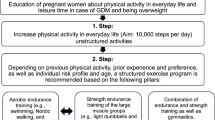Abstract
The additional energy requirements of pregnancy are needed for increases in maternal (breast, uterus and adipose) and feto-placental tissue accrued during pregnancy as well as the additional running cost of pregnancy for example increased cardiac output. Based on prospective longitudinal studies, the additional energy requirements of pregnancy range from >500 MJ in Swedish women to net savings of approximately 50 MJ in women in The Gambia with their usual nutritional intake. In addition to the wide variation in estimated energy expenditure among various ethnic populations, there is as much as a 10–20 fold range in the total energy cost of pregnancy and lactation within relatively homogenous populations.
The estimates of energy intake in these studies, however, are generally less than the estimates of total energy expenditure. The discrepancy between energy intake and energy expenditure during pregnancy is most probably due to several factors including decreased maternal activity, unreliable reporting of energy intake and possibly increased metabolic efficiency of basal metabolic rate, thermic effect of foods and physical activity.
Based on recent studies, variations in maternal pregravid glucose insulin sensitivity may account for part of the observed variability associated with maternal metabolic adaptations during pregnancy. Decreases in insulin sensitivity have a significant inverse correlation with accretion of adipose tissue in early pregnancy. Likewise, there is a significant inverse correlation between decreases in basal oxygen consumption with increases in endogenous glucose production. The mechanism for these changes remain speculative. Additionally, although serum leptin concentrations increase 66% in early pregnancy and are correlated with maternal fat mass and basal energy expenditure, the increases in serum leptin occur prior to any significant increases in body fat or basal metabolic rate suggesting that pregnancy represents another leptin resistant state.
Based on these data, specific recommendations for acceptable carbohydrate and fat intake during pregnancy and lactation are not possible for every woman at this time. Additional prospective studies, evaluating long-term maternal and neonatal outcome are needed before more meaningful nutritional recommendations can be proposed.
This is a preview of subscription content, access via your institution
Access options
Subscribe to this journal
Receive 12 print issues and online access
$259.00 per year
only $21.58 per issue
Buy this article
- Purchase on Springer Link
- Instant access to full article PDF
Prices may be subject to local taxes which are calculated during checkout
Similar content being viewed by others
Author information
Authors and Affiliations
Rights and permissions
About this article
Cite this article
Catalano, P. Pregnancy and lactation in relation to range of acceptable carbohydrate and fat intake. Eur J Clin Nutr 53 (Suppl 1), s124–s135 (1999). https://doi.org/10.1038/sj.ejcn.1600753
Published:
Issue Date:
DOI: https://doi.org/10.1038/sj.ejcn.1600753
This article is cited by
-
Low Resting Energy Expenditure Is Associated with High Gestational Weight Gain Only When Resting Energy Expenditure Fluctuates
Reproductive Sciences (2021)
-
Regulation of basal metabolic rate in uncomplicated pregnancy and in gestational diabetes mellitus
Hormones (2017)
-
Prospective assessment of exclusive breastfeeding in relation to weight change in women
International Journal of Obesity (2003)



